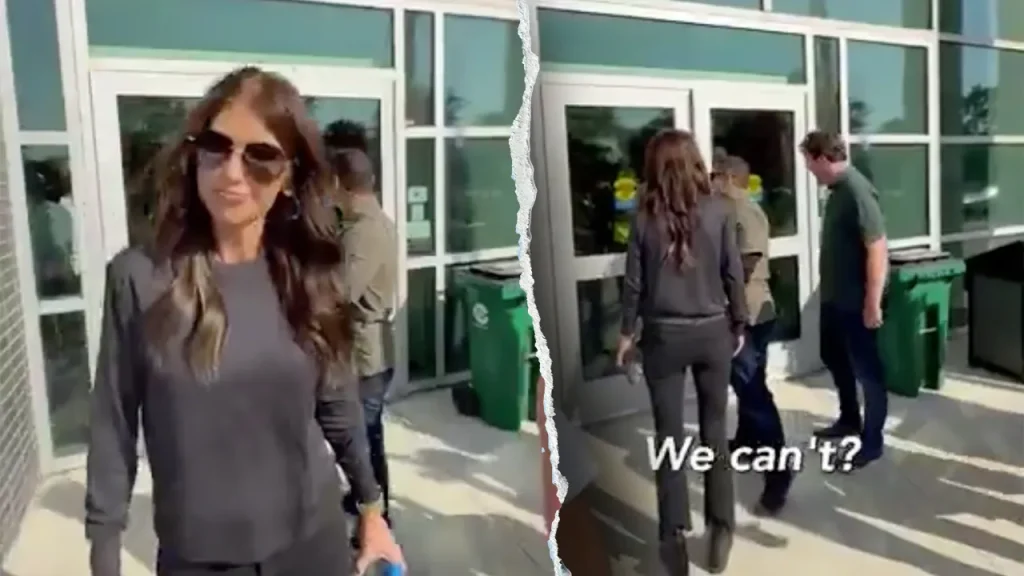Federal Tensions Rise in Illinois Suburb as DHS Secretary Noem Faces Local Resistance
Tensions between federal and local authorities escalated Friday when Department of Homeland Security Secretary Kristi Noem reported being denied access to a public building in Broadview, Illinois. The incident occurred amid ongoing protests at a nearby Immigration and Customs Enforcement (ICE) facility, where federal agents were engaged in operations that have drawn significant local opposition. According to Noem, she and her staff were simply seeking a “bathroom break” at the Village of Broadview Municipal Building when they were refused entry. A video of the encounter shows Noem calmly accepting the refusal after someone inside firmly denied her request. The Secretary later posted on social media that the building receives federal funding and criticized Illinois Governor J.B. Pritzker’s administration for what she characterized as disrespectful treatment of federal law enforcement.
The local perspective, however, differs significantly from Noem’s account. Village spokesperson David Ormsby stated that Noem appeared “unannounced” seeking a meeting with Mayor Katrina Thompson, who was not present at the time. Following the incident, Thompson reportedly went to the ICE center accompanied by the Broadview Police Chief to request removal of what they described as an “illegal fence,” but was told Noem was unavailable. DHS officials strongly contested this version of events, with Assistant Secretary for Public Affairs Tricia McLaughlin insisting, “She didn’t ask for a meeting. She asked to use the restroom. This is insane.” This conflicting narrative highlights the growing communication breakdown between federal and local authorities in managing immigration enforcement operations.
The backdrop to this seemingly minor encounter is far more significant – ongoing protests at the Broadview ICE processing facility where tensions have reached a boiling point. Fox News reported that federal agents deployed pepper balls, tear gas, and rubber bullets to disperse crowds who were reportedly blocking federal operations. More than a dozen protesters were arrested during these confrontations, underscoring the increasingly volatile nature of immigration enforcement activities in the Chicago suburb. These tactics have drawn sharp criticism from local officials and Governor Pritzker, who have characterized the federal response as excessive and traumatizing to local communities.
Governor Pritzker made his opposition clear in strong statements directed at Secretary Noem, accusing her of overseeing enforcement tactics that violated rights and traumatized Illinois families. He went so far as to suggest she “should no longer be able to step foot inside the State of Illinois without any form of public accountability.” Pritzker’s office alleged that during a previous visit, Noem “snuck in during the early morning to film social media videos and fled before sunrise,” and criticized her for not holding press conferences to answer questions about the administration’s actions. The governor’s statement reflected growing frustration with what he views as federal overreach, declaring, “Illinois is not a photo opportunity or warzone, it’s a sovereign state where our people deserve rights, respect, and answers.”
DHS officials responded with equal force to Pritzker’s criticisms. McLaughlin fired back with a statement telling the governor to “Grow up and start protecting the people of your own state,” and accused him of failing to address violent offenders in Illinois communities. Her statement claimed, “Federal law enforcement has to be here because JB Pritzker refuses to do his job and has allowed violent illegal alien criminals to terrorize Illinois communities for years.” This exchange highlights the fundamental disagreement between federal immigration authorities and state officials regarding jurisdiction, enforcement priorities, and methods – a conflict that has intensified under the current administration’s immigration policies.
What began as a simple request to use a public restroom has become emblematic of the deeper divisions in American immigration policy enforcement. The incident in Broadview reflects the nationwide tension between federal immigration priorities and local governance concerns. As federal agents continue operations at the ICE facility amid ongoing protests, the conflict between Secretary Noem and Governor Pritzker represents more than personal disagreement – it symbolizes the fractured approach to immigration enforcement across different levels of government. Local residents find themselves caught between competing authorities, with protest actions and law enforcement responses creating an increasingly unstable environment in what was once a quiet Chicago suburb. Without improved communication and coordination between federal and local officials, such confrontations seem likely to continue and potentially escalate further.


